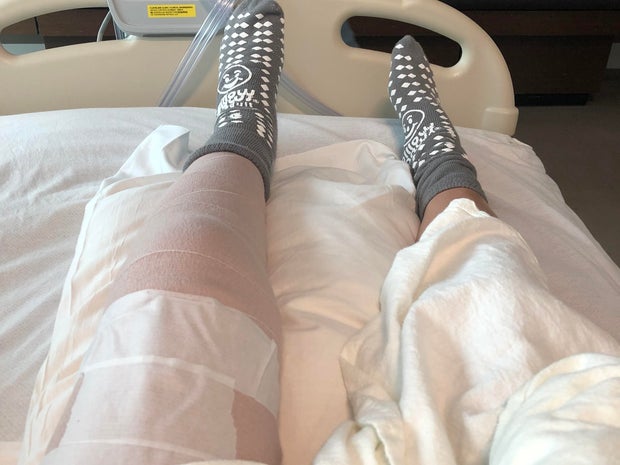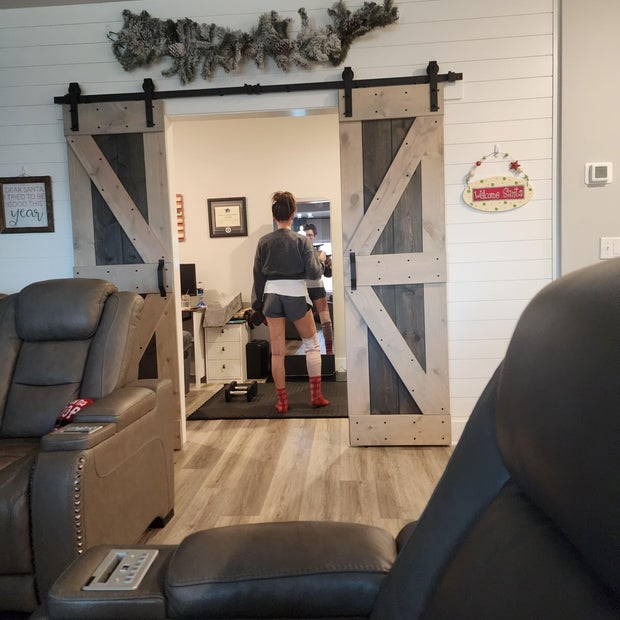Military veteran and avid runner Sierra Prindle was used to muscle pain, but the agony she was feeling in her left calf was something she’d never experienced before.
It started when she was around 30, with muscle spasms and weakness after working out. Then, on a camping trip with her mom and her two kids, Prindle sat down and couldn’t get back up. At the emergency room, doctors diagnosed her with a slipped disc and prescribed steroids.
But as the years went on, the pain got worse. Prindle said she was “constantly going to doctors,” but no one had an answer for her. Some suggested the pain was all in her head. Others suggested tests that found nothing or prescribed medications that didn’t make a difference. Her insurance carrier tried to drop her from its plan. Prindle estimated she had hundreds of tests, including CAT scans, MRIs and X-rays.
Meanwhile, the pain was becoming so persistent that Prindle couldn’t sleep at night. For years, every day was a struggle.
“It was rough. It was very hard for me to navigate life,” Prindle, now 37, said. “I was dragging my leg. I was exhausted. I couldn’t not work. I couldn’t not be a mom. My life was completely affected.”
Sierra Prindle
A rare diagnosis
Prindle started receiving Botox injections in her leg to manage the pain while seeing other specialists in hopes of getting an answer. In 2021, half a decade after the pain started, one of those specialists finally made a diagnosis: Popliteal artery entrapment syndrome, or PAES.
“I just started crying. I couldn’t focus,” Prindle said. “I was just so relieved to have the diagnosis. It was a sigh of relief.”
The condition is rare, according to Dr. Katherine Gallagher, a vascular surgeon at the University of Michigan Health Frankel Cardiovascular Center, who was not involved in Prindle’s treatment. The condition covers six different types of abnormalities, depending on exactly how the artery is being affected. Generally, it means the popliteal artery, which supplies blood to the lower leg, is compressed by the muscles and tendons in the area, Gallagher said. A person can be born with the condition, or can develop it from intensive exercise, Gallagher said.
The rarity of PAES makes it hard to diagnose, Gallagher said. It can be misdiagnosed as chronic compartment syndrome or other orthopedic disorders. Prindle’s years-long struggle to be diagnosed isn’t uncommon, Gallagher said.
“It’s not something that everybody sees every day,” Gallagher said. “Most of the patients I treat have been dealing with these symptoms for years.”
Once Prindle had a diagnosis, she sought treatment. She underwent a bypass surgery, which rerouted blood flow through the popliteal artery. But while recovering, Prindle realized something was wrong.
“I was just experiencing more pain than ever. My toes were numb. I was terrified,” Prindle recalled. “My sister-in-law is a nurse. She called me. I said, ‘I don’t think I’m fixed.'”
Seeking further treatment
After their phone call, Prindle’s sister-in-law started researching. She came upon a Facebook page where other people diagnosed with PAES shared their stories. Prindle joined the Facebook page and noticed one doctor’s name kept popping up. Dr. Sean Lyden, the chairman of vascular surgery at the Cleveland Clinic, was a leader in PAES treatment. His office was also just an hour and a half from Prindle’s Ohio home.
“He got me in almost right away, thankfully. I mentioned the (Facebook page) and he was like ‘I hear about it all the time,'” Prindle said.
Lyden typically treats 100 to 200 patients for PAES a year, he said, and specializes in treating the disorder. He recommended a surgery that would remove small portions of Prindle’s gastrocnemius and popliteus muscles. This is a common form of treatment, Gallagher said. Removing the muscle relieves compression on the popliteal artery, reducing a patient’s symptoms and pain. Lyden is one of a handful of surgeons in the U.S. who do the procedure.
Sierra Prindle
Prindle had the surgery on her left leg the day after she met Lyden. The recovery was hard, she said. While regaining function in her left leg, she realized her right leg was also in pain. Lyden and Gallagher both said this isn’t uncommon: One leg tends to be in worse shape, and that pain can obscure other symptoms. Lyden did a second surgery to treat Prindle’s right leg in November 2024.
Recovering and regaining strength
The surgeries corrected Prindle’s legs and have allowed her to return to a semblance of a normal life. Her right leg is “100% better,” she said. Lasting nerve damage in her left leg means she still has some pain. She often takes a muscle relaxer to sleep at night because of discomfort in that limb. But the numbness, tingling and overall pain are reduced, she said.
She and her family have since moved to Florida and live near the beach. In addition to juggling work as a contract specialist for the U.S. Air Force and a busy family life, Prindle is focused on returning to her active lifestyle. She can handle strength training, climbing and playing golf but anything that requires the use of just one leg is a no-go right now. Prindle hopes she can eventually recover those abilities.
Sierra Prindle
“I would love to run again,” Prindle said. “It’s one thing that I’ve missed for so long. I used to love being athletic. I would love to figure out a way to get rid of this nerve damage … I would love to just get to be able to do everything that I want, with no restrictions.”
Prindle said she hopes her story inspires others to push for answers when they know something is wrong.
“I should have given up a million times,” Prindle said. “I can’t tell you how many times I left a doctor’s office crying … Don’t give up, because there is a doctor out there that will help you. You just have to find somebody that understands your condition or understands that there is something wrong.”







